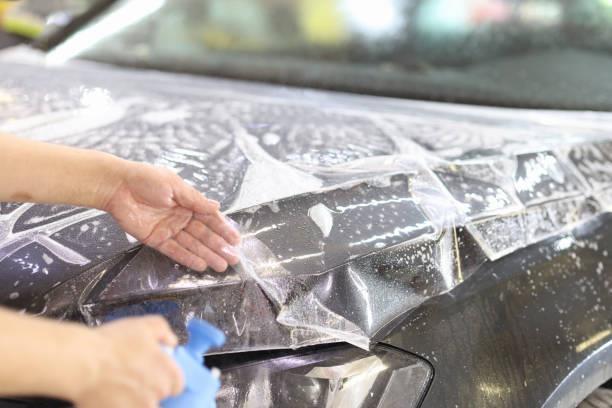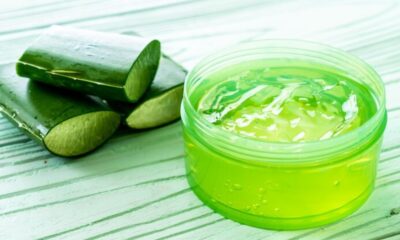Car
PPF or Ceramic Coating? Which Offers Better Protection for Your Car?

Whether you decide to use Paint Protection Film (PPF) or to go for that perfect finish of ceramic coating, your car’s exterior will be protected. Each has its advantages, and only by comparing them, you will be able to choose the one perfect for your car. In this article, we first introduce PPF and ceramic coating, the benefits of using them, and why it is necessary to cooperate with a reliable PPF factory to achieve better results.
Paint Protection Film (PPF)
PPF is a clear plastic material developed in the urethane layer and is used to provide coating to your vehicle’s surface so as to protect it from more extensive damage from various environmental factors. Its main function is to protect your automobile from flying objects, chippings, rubs or any other surface wear. One of the greatest strengths of PPF is that it automatically repairs itself; so, small scratches and swirl marks become invisible once exposed to heat or sunlight. This technology helps to maintain the exterior look of your car as it was when it was brand new.
Regarding additional benefits, two component PPF products from the best PPF factories are unique by providing UV resistance, stain protection, and hydrophobicity. These features assist in covering your car from direct sunlight hence avoiding fading and discoloration settling on your car and other forming elements such as bird droppings as well as tree saps. Most of the modern PPF films are also smooth, which gives the car a shiny look while giving it proper protection. Minimizing paint overspray has the highest value in the hood, bumper, side mirrors, and door edges because of the deep drawing process, making it ideal for PPF. Some types of PPFs come with warranties as long as 5-10 years; professional PPF companies guarantee their product will deliver dependable, long-term protection.
What Is Ceramic Coating?
Ceramic coating is a liquid polymer that is applied to the paint in your car allowing it to chemically bond to form a semi permanent coating. However, we have to make the point that ceramic coating does not protect a car like a physical barrier that is afforded by Paint Protection Film through chips or scratches. Instead, it gives the car a better look and shields it from the surrounding environment debris and chemicals. Among the benefits of ceramic coating is that it is hydrophilic, therefore water and dirt do not stick on the surface as normally expected. This makes it easier to pass a car interior through vacuum cleaner and to maintain that neat look of the car.
Ceramic coating also brings respectable effectiveness in preventing sun’s rays from oxidizing paint and fading. It produces a wet-look shine which enhances the look of your car’s paint work giving it that newly painted look. As you know, it cannot protect your car against impact but ceramic coating is the best option for those owners who seek for the product which will help to keep the car brilliant and clean without spending much time on it. There are those car owners who prefer to apply both PPF and ceramic coating because they both offer physical and visual shield.
Benefits of Combining PPF and Ceramic Coating
The application of both PPF and ceramic coating is very essential in protecting automobiles since it is a way of including the best of each innovation. PPF provides severest physical skin, protecting your automobile from being scratched, chipped or abraded by rocks and other elements on the roads. On the other hand, ceramic coating strengthens the exterior of the car, applies a thin layer of gloss and makes the surface hydrophobic which makes washing very easy.
Sealing over PPF with ceramic coating not only increases the level of paint preservation but also increases the ability of the film to self-clean. Here, bumps are not easily scratched as dirt, water as well as contaminants do not stick on the surface hence avoiding frequent washing of the car. Moreover, it is possible to use ceramic coating on the parts of the car’s body which have not been covered with PPF, so that all the exterior could look equally protected. Most PPF firms today provide PPF products that contain features of ceramic coating, with easy application and full car protection as a whole. This synergy makes it possible that your car looks as good and is as safe as the day you bought it for many years.
PPF vs. Ceramic Coating: Which Is Right for You?
In general, the care of black PPF and ceramic coating fully depends on you, your car usage, climate, and personal preferences. If you use your car often in freeways or bumpy roads where the paint of your car is more likely to be chipped or scratched, then PPF is for you. It gives a huge coverage with strong abrasion on vulnerable parts and guarantees your car’s exterior will remain pristine. PPF films manufactured by good PPF factories are developed to provide long term performance and better handling to your vehicle even in extreme weather conditions.
In its turn, ceramic coating will be suitable for those people who value appearance and do not wish to spend time on regular cleaning. It also has the ability of being NON-POROUS and has a high-gloss which makes your car easier to wax and easier to clean. If your aim is to maintain the shiny ‘as new’ look, then ceramic coating comes in inexpensive. However, to achieve maximum coverage and durability along with the best appearance, the application of PPF and ceramic coating is the best option. This approach guarantees quality, great finish, durability and coverage that will make your car stand out like an emerald among jewels.
Conclusion
This is true since Paint Protection Film and ceramic coating are two of the best solutions for protecting and improving the exterior of your car. PPF provides a higher physical barrier against scrapes, spots, and various dents making the compound suitable for car owners who wish to protect their cars against various accidents. PPF and trusted PPF factories offer handy features such as self-healing and that the product is hydrophobic so that it would not deteriorate quickly. That is also true, yet ceramic coating is proven to be superior to paint protection in terms of enhancing shine, minimizing the work on car cleaning, and shielding from pollutants.
As for the best protection, the use of PPF and ceramic coating for car owners should be the best solution. PPF gives long term protection to physical damages whereas the ceramic coating adds shine and makes washing easy. Choosing either solution or both, it is beneficial for your car’s protection, design, and easier to maintain for several years. Future proof your car today with PPF, ceramic coating or both and drive off in a car that looks like the first day, every day.
Car
Your Guide to the Best Kia Dealership Brisbane Has to Offer

Choosing the right Kia dealership Brisbane residents can trust is a key part of finding a vehicle that meets your lifestyle and budget. Whether you’re in the market for a new model, a quality used car, or reliable servicing, the right dealership makes all the difference.
In a competitive market like Brisbane, narrowing down your options can be overwhelming. That’s why it helps to know what makes one Brisbane Kia dealership stand out from the rest.
Why Choose a Kia?
Kia vehicles are known for blending affordability, modern technology, and sleek design. From compact city-friendly cars to spacious SUVs, the range available at a trusted Kia dealership Brisbane drivers rely on is well-suited to both urban and suburban lifestyles.
Popular models include:
- Kia Sportage: A versatile SUV that’s perfect for growing families, daily commutes, or spontaneous weekend getaways. It offers generous space, advanced safety features, and a smooth, comfortable ride.
- Kia Cerato: A sleek and compact sedan designed for drivers who want style, practicality, and cutting-edge tech in one affordable package. Ideal for city driving and small families.
- Kia EV6: An innovative electric vehicle that pushes the boundaries of design and performance. With impressive range, rapid charging, and zero emissions, it’s leading the shift toward sustainable driving.
With a reputation for reliability and an industry-leading 7-year warranty, it’s no surprise that Kia remains one of the fastest-growing car brands in Australia.
Finding a Trusted Kia Dealership in Brisbane
When it comes to selecting a Kia dealership Brisbane location, customer service and ongoing support matter just as much as price. A reputable dealer will offer more than just cars — they’ll provide a complete ownership experience.
Toowong Kia stands out as one of the most trusted names in the area, offering a wide range of models, competitive pricing, and expert support. Their team is focused on helping customers select the ideal car for their needs, with personalized service every step of the way.
What You Can Expect
A great dealership will offer services and features that go beyond the initial sale:
| Feature | What It Means for You |
| Extensive Inventory | A broad range of new and pre-owned Kia vehicles |
| Flexible Finance Options | Tailored plans to suit different budgets |
| On-Site Kia Service Center | Easy access to maintenance, repairs, and parts |
| Factory-Trained Technicians | Assurance your vehicle is in expert hands |
| Trade-In Support | Smooth and fair trade-in process for your old car |
This comprehensive support makes it easier to manage your car’s full life cycle, from purchase to long-term upkeep.
Your Local Kia Service Center Brisbane Drivers Recommend
A trusted Kia service center in Brisbane that drivers rely on is essential for peace of mind. Regular maintenance ensures your car performs its best, lasts longer, and retains value. A certified service team understands your Kia inside and out, using genuine parts and up-to-date diagnostic tools.
Whether it’s a routine service or more extensive repair work, qualified technicians help keep your vehicle in peak condition.
Reliable Kia Car Sales Brisbane Locals Trust

.When considering Kia car sales in Brisbane, transparency and trust are key. The best dealerships provide clear pricing, honest advice, and access to the latest offers and promotions. You’ll also benefit from:
- A flexible test drive program that lets you experience different models at your convenience
- A user-friendly online platform to explore the full inventory, compare features, and shortlist vehicles before stepping into the showroom
Continued support after your purchase, including warranty guidance, scheduled servicing, and assistance whenever needed
Choosing the best Kia dealership in Brisbane can ultimately save you time, money, and stress. With the right team behind you, owning a Kia becomes a smooth and enjoyable experience.
Ready to find the right Kia for your lifestyle? Explore Brisbane’s top dealership and enjoy reliable service, competitive pricing, and expert support every step of the way.
Car
The Importance of Witness Testimonies in Car Accident Cases

Witness testimony is a crucial piece of evidence in car accident cases, providing critical insights into the events leading up to the accident. It can provide an unbiased perspective that can strengthen a case. Witness accounts from other drivers, pedestrians, or bystanders can provide a clearer picture of what occurred, making them essential in determining fault and securing fair compensation. This blog explores the importance of witness testimonies in car accident cases.
Role of Witnesses in Car Accidents
Witness testimonies in car accident cases are vital to understanding the complexities of such events. At the scene of an accident, tensions are often high, and emotions can cloud the judgment of those directly involved. This is where witnesses become invaluable, offering an external perspective that may be critical in legal proceedings. These unbiased accounts help outline the sequence of events that transpired, the involvement of each party, and any contributing factors that led to the accident.
How Witness Testimonies Strengthen Claims
experienced car accident lawyer, establishing fault is immensely challenging without substantial evidence. This is where witness testimonies take on a paramount role. When the accounts of those involved contradict each other, a third-party perspective can illuminate the truth. Legal professionals, such as car accident lawyer, often leverage these statements to fortify their arguments in court or during negotiations. Witness accounts can significantly influence the outcome, with more precise, detailed statements providing a solid backbone for a case. Moreover, insurance companies often base their decisions on the strength and credibility of these testimonies, making them vital for claim settlements and jury outcomes.
Verifying the Credibility of Testimonies
Ensuring the reliability of witness testimonies is a crucial step in making them practical tools in legal battles. Various factors determine a witness’s credibility, including their location during the incident, their relationship to any parties involved, and their ability to remember and articulate the specifics of the accident. Legal teams analyze these elements carefully to ensure the witness can provide a coherent and impartial account. This due diligence is imperative to avoid any fallacies within testimonies that adversaries might exploit, thus fortifying the overall strength of the legal argument presented in court.
Technology’s Role in Supporting Testimonies
Technology has increasingly played a supporting role in corroborating witness accounts. The integration of dashcams, smartphones, and other recording devices provides an additional layer of evidence that can either substantiate or challenge human recollections. These technological aids are objective documentation, offering unbiased proof to support or refute witness statements. Technological advancements have added profound depth to judicial processes, which showcases the intersection of modern technology and legal proceedings.
Common Challenges with Witness Testimonies
Despite their invaluable contributions, witness testimonies are not without challenges. Recalling an event accurately can be difficult, mainly as time passes, with memories diluted or altered. Emotional responses at the moment or in subsequent retellings can unknowingly influence a witness’s narrative, leading to inconsistencies. Such issues necessitate a rigorous process of cross-examination and verification against tangible evidence to safeguard the integrity of the testimonies. Overcoming these hurdles requires meticulous legal expertise to ensure that testimonies contribute positively to the legal process rather than detract from it.
Car
Understanding Brake Systems: A Beginner’s Guide

Introduction to Brake Systems
Brake systems are the cornerstone of vehicle safety, designed to provide the control necessary to modulate speed and safely bring vehicles to a halt. These systems, whether compact cars or heavy-duty trucks, ensure safety and efficiency across all vehicles. For anyone experiencing brake issues, it is crucial to consider acquiring brake repair Edmonds WA, to uphold road safety.
Understanding your vehicle’s braking system is not just about knowing how to stop a car; it is about understanding the mechanisms that ensure it happens securely and consistently. The stresses your brakes endure daily necessitate routine check-ups. Equipping yourself with knowledge of your brake system can lead to proactive maintenance, curtailing risks associated with brake failures.
Types of Brake Systems
Today, vehicles are predominantly equipped with two types of braking technology: disc brakes and drum brakes. Disc brakes provide exceptional performance; they use calipers to press pairs of pads against a disc or rotor. In contrast, drum brakes utilize shoes pressing outward against a rotating drum, making them favorable due to their simplicity and cost-effectiveness.
Disc brakes are standard in modern vehicles, and they offer the advantages of effective heat dissipation and greater stopping efficiency. Conversely, drum brakes, found in older vehicle models, offer certain mechanical advantages and are more economical. Understanding these distinctions can help decide the best fit for driving requirements and vehicle design.
Key Components
Several components are crucial to the optimal functioning of a brake system. These include brake pads, rotors, calipers, and brake fluid. Brake pads generate necessary friction against the rotors, slowing down the vehicle, while rotors help disperse the heat from this friction. Calipers, which house the pads, clamp down on the rotors to initiate the braking process.
Moreover, brake fluid is vital, facilitating the force transition from your brake pedal to the brakes. Knowing these components’ detailed function and maintenance is imperative to diagnosing problems and ensuring the vehicle operates smoothly and safely.
Maintenance Tips
Regular maintenance is paramount to ensuring the durability and efficiency of your brake system, thereby maintaining vehicle safety. Essential maintenance tasks include frequently checking the thickness of brake pads for wear, inspecting rotors for any damage or warping, and ensuring the brake fluid is free from contaminants and maintained at optimal levels.
Opting for high-quality replacement parts during maintenance can significantly enhance the system’s reliability and save on future costs. Professional assessments can detect issues not evident in routine checks, and timely replacements of worn-out components can prevent the escalation of minor problems, ensuring continued safety and performance.
Common Issues and Solutions
Braking systems can develop a range of issues, such as squealing noises, decreased braking performance, or vibrations when the brakes are applied. Common causative factors include wear on the brake pads, misaligned rotors, or air in the brake lines. Attention is required to prevent these minor problems from developing into serious, costly repairs.
Understanding these warning symptoms is essential to addressing brake-related deficiencies promptly. As industry experts advocate, regular maintenance is crucial for early problem detection and maintaining a vehicle’s safety and longevity.
The Importance of Brake Safety
Ensuring that brakes are functioning correctly is imperative for driver and passenger safety and the safety of others on the road. Faulty brakes pose significant risks, and it is crucial to prioritize regular inspections and timely repairs to prevent accidents.
If you ever notice unusual sounds or feel a change in braking performance, seeking immediate attention from a certified professional is vital to maintaining safety standards and fulfilling legal road safety requirements.
Innovations in Brake Technology
Recent technological advances have driven significant improvements in vehicle brake systems. From anti-lock braking systems (ABS) to electronic brakeforce distribution, these technologies enhance braking precision and safety, providing drivers better control and significantly reducing accident risks.
Modern braking technology ensures vehicles can perform efficiently across diverse conditions and driving scenarios. Staying informed about these innovations allows consumers to make well-informed decisions regarding vehicle maintenance and purchasing options.
Concluding Thoughts
Every vehicle owner must achieve a comprehensive understanding of brake systems. This enables them to perform informed maintenance, respond appropriately to issues, and stay updated on technological advances in braking. If brake maintenance or repair is needed, consulting with services like those providing brake repair is a wise step toward maintaining vehicle safety and preparedness.
-

 GENERAL11 months ago
GENERAL11 months agoFrom Fan Art to Original Works: The Diversity of doujindesu Creations
-

 Entertainment7 months ago
Entertainment7 months agoEnchantment & Excitement: Crafting Unforgettable Event Experiences
-

 GENERAL8 months ago
GENERAL8 months agoEngland Business Visa Requirements for American and International Citizens in 2025: A Guide for Entrepreneurs
-

 GENERAL7 months ago
GENERAL7 months agoCrossword Conundrum: The Significance of vault opener nyt crossword
-

 GENERAL10 months ago
GENERAL10 months agoLatest Trends in Men’s and Women’s Jackets for the Upcoming Season
-

 GENERAL7 months ago
GENERAL7 months agoExploring the World of nhentai.nef: A Comprehensive Guide for New Users
-

 Health11 months ago
Health11 months agoDiscovering gel ooru: The Ultimate Guide to This Unique Traditional Craft
-

 GENERAL11 months ago
GENERAL11 months agoWhy raterpoint is Revolutionizing Customer Feedback
